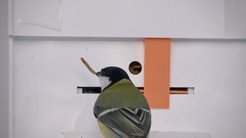Backyard birds learn from their new neighbors when moving house
Immigrantion seems to trigger great tits to rapidly learn useful tricks from local experts
Scientists have found a trigger for social learning in wild animals. An experiment on great tits has pinpointed a single factor—immigration—that can cause birds to pay close attention to others, leading them to rapidly adopt useful behaviors. The study is the first to provide experimental support of a long-held assumption that immigrants should strategically use social learning. The study, conducted by scientists from the Max Planck Institute of Animal Behavior (MPI-AB) and the Cluster of Excellence Collective Behaviour at the University of Konstanz in Germany, is published November 14 in PLOS Biology.

Many animals that live in groups learn from one another, but few wild animals have opened a window into understanding animal social learning like a single bird species: the great tits. Great tits flew to fame in the 1920s after birds started opening the foil lids of milk bottles to feed on the cream within. Residents of a small town in England were the first to report the behavior, but soon people across Europe were opening their doors to find that their milk bottles had been raided by birds. The behavior spread so far so quickly that scientists considered it unlikely that individual birds across a continent were inventing this trick on their own. Could the birds be learning from each other?
The answer remained hidden until 2015 when a team led by Lucy Aplin, then at the University of Oxford, conducted an experiment on a population of great tits in an English forest. Her experiment showed that birds were able to learn how to liberate food from a puzzle box by copying the solution from others—confirming that the original milk-raiding birds had also been passing on their thieving ways to their flock.
“Social learning is a great shortcut when it comes to safely testing new waters,” says Chimento, a postdoctoral researcher who worked in Aplin’s team at the MPI-AB. “Paying attention to what others are doing gives you the chance to see whether a new behavior is beneficial, or potentially dangerous. Copying it means that you too can reap the reward.”
By copying the behaviors of others, animals can potentially unlock resources. So Chimento and Aplin wanted to know if there was an ingredient that would catalyze social learning, allowing animals to more efficiently realize its rewards. According to theory, there was a possibility: “Theoretical models have suggested that animals should change their social learning strategy when faced with new environments,” says Chimento who is now at the Cluster of Excellence Collective Behaviour at the University of Konstanz. In other words, when animals move into a new place, they might learn more from others. “But nobody has experimentally shown this in non-human animals,” he says.

Using an automated puzzle box system they developed, the team designed an experiment to test this immigration hypothesis. They created experimental social groups of wild-caught great tits. Each group was provided a tutor which was trained to access food from a puzzle box by either pushing the door left or right. One tutor was then released into each group, so that their flock mates learned to prefer using one solution over another.
Next came the immigration event. Right-pushing birds were transferred into aviaries where resident birds were using the left-hand solution, and vice versa. Not only did immigrants see that residents were opening the puzzle box in a new way, but in some groups, the newcomers also discovered that residents scored a superior reward by doing so.
“What’s important is that the immigrants were blind to the fact that the food reward had changed,” said Chimento, the study’s lead author. “Immigrants could only know something changed by either watching the residents use the puzzle, or by trying the other side themselves.”
And watch, the immigrants did. After being released into the new aviary, the vast majority of immigrants—80 percent—switched their method immediately. Instead of attempting the method they had been trained on, the immigrants used the resident solution on their first try. Chimento says that this stark result makes a compelling case that social learning was at play: “Of course we can’t ask the birds exactly where they were getting their information from, but these behavioral patterns are striking enough to suggest that the birds were watching residents very closely from the moment they entered their new social group.”
But there was an extra twist. These immigrants were not just moved to a place where residents were getting better food; their visual world was also drastically transformed. The scientists manipulated the environment of immigrants by changing the foliage in the experimental aviaries as well.
And it was the altered visual environment that proved to be the linchpin for learning. In trials where the foliage was not changed, only 25 percent of the newcomers tried the resident solution on the first attempt, even when locals were earning better food. “They didn’t necessarily ignore the residents, but they took much longer to all switch over to the more rewarding solution. Our analyses suggested this was because they weren’t as influenced by the residents” Chimento says.
This is the first experimental evidence to show the powerful impact that immigration has on how animals learn from each other. And in the real world, this can be profound.
Says Aplin, the study’s senior author: “In nature, animals are often moving from one environment to another, so it’s helpful to have a strategy to weed out what are good and bad behaviors to use in the new place.” That’s why the theory predicted that different learning strategies should evolve to act as a filter when animals enter new environments. “Our study provided the experimental evidence to show that this is also what happens in real life,” she says.













